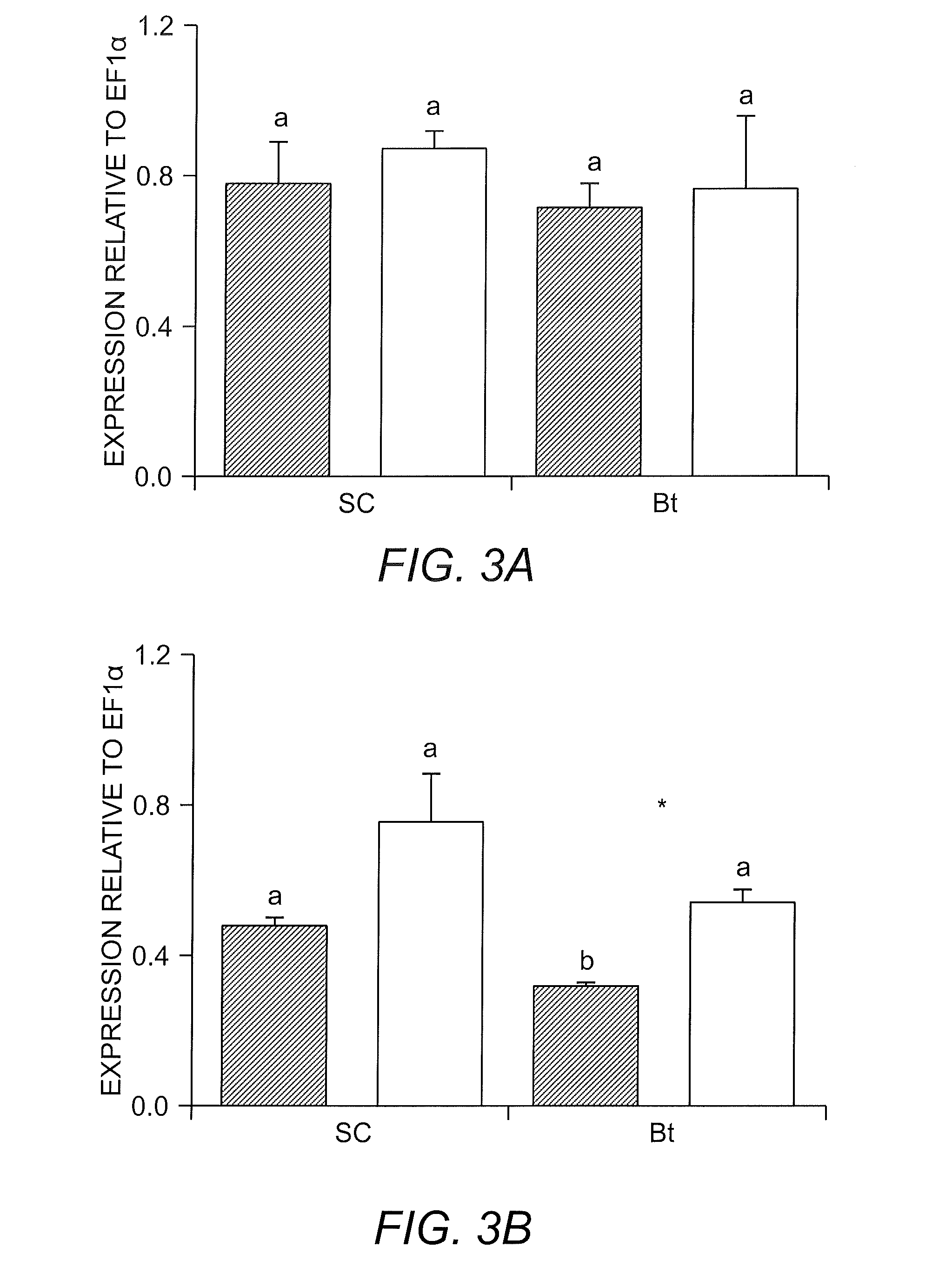Bacillus thuringiensis toxin resistance assay
a technology of toxin resistance and bacillus thuringiensis, which is applied in the field of toxin resistance assay of bacillus thuringiensis, can solve the problems of bt resistance being disastrous for growers relying on bt technology for wcr management, several limitations, and cost-escalating insecticide use, and achieves the effects of determining resistance or susceptibility, and reducing the number o
- Summary
- Abstract
- Description
- Claims
- Application Information
AI Technical Summary
Benefits of technology
Problems solved by technology
Method used
Image
Examples
example 1
Protease Activity in WCR Adults
[0038]It was observed that Bt toxins affected the gut physiology of WCR adults. These results are supported by an extensive study of populations of WCR throughout Illinois for three years. It was found that Bt toxins affected the cysteine protease activity of the guts of WCR adults. Initially, the activity of two populations of WCR from Paxton and Champaign were measured.
[0039]The Paxton, Ill. population came from a stacked pyramid Bt corn (which includes Cry3Bb1 and Cry34 / 35) that had been used in that field for at least 5 to 6 consecutive years. This field had a high abundance of adults in the field, and thus, had the potential for having a resistant population.
[0040]The Urbana, Ill. (L40) population was a population from a rotated non-Bt corn plot. As shown in FIG. 1, Bt corn significantly reduced the activity of cysteine proteases in both populations. This effect was reverted by feeding WCR adults with non-Bt corn diets. The recovery of the activit...
example 2
Bt Resistance Protease Activity Assay
[0046]Collection of Insects.
[0047]Insect populations are collected from the field manually using nets or containers. A convenient method is to set up tents in non-Bt / Bt fields before adults emerge so that all insects emerging from the particular field are enclosed and available for sampling.
[0048]Insect Maintenance.
[0049]All insects are kept on corn ears or silks from their original fields.
[0050]Dietary Treatments.
[0051]Insects are treated with tissues of non-transgenic or transgenic corn tissues (with the trait to be tested). Insects are maintained on each diet for 5 (or 4) days.
[0052]Collection of Digestive Tract Samples.
[0053]After dietary treatments, all insects are paralyzed with chloroform and complete digestive tracts are excised with fine tweezers. Multiple guts are pooled into one tube as an independent biological replicate (with the same sex ratio and gut number across treatments). For protease samples, four or more (depending on insect...
example 3
Bt Resistance Protease Gene Expression Assay
[0063]Collection of Insects.
[0064]Insect populations are collected from the field manually using nets or containers. A convenient method is to set up tents in non-Bt / Bt fields before adults emerge so that all insects emerging from the particular field are enclosed and available for sampling.
[0065]Insect Maintenance.
[0066]All insects are kept on corn ears or silks from their original fields.
[0067]Dietary Treatments.
[0068]Insects are treated with tissues of non-transgenic or transgenic corn tissues (with the trait to be tested). Insects are maintained on each diet for 4 or 5 days (same across treatments).
[0069]Collection of Digestive Tract Samples.
[0070]After dietary treatments, all insects are paralyzed with chloroform and complete digestive tracts are excised with fine tweezers. Multiple gut samples are pooled into one tube as an independent sample (with the same sex ratio and gut number across treatments). For RNA samples, five insect gut...
PUM
| Property | Measurement | Unit |
|---|---|---|
| Electrical resistance | aaaaa | aaaaa |
Abstract
Description
Claims
Application Information
 Login to View More
Login to View More - R&D
- Intellectual Property
- Life Sciences
- Materials
- Tech Scout
- Unparalleled Data Quality
- Higher Quality Content
- 60% Fewer Hallucinations
Browse by: Latest US Patents, China's latest patents, Technical Efficacy Thesaurus, Application Domain, Technology Topic, Popular Technical Reports.
© 2025 PatSnap. All rights reserved.Legal|Privacy policy|Modern Slavery Act Transparency Statement|Sitemap|About US| Contact US: help@patsnap.com



